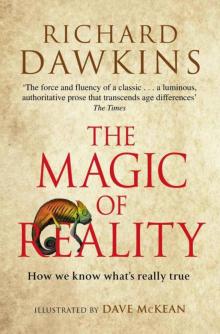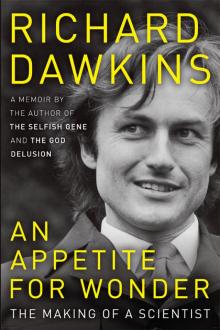- Home
- Richard Dawkins
The Blind Watchmaker Page 31
The Blind Watchmaker Read online
Page 31
Suppose, first, that nature had been extraordinarily kind to palaeontologists (or perhaps unkind, when you think of the extra work involved), and given them a fossil of every animal that ever lived. If we could indeed look at such a complete fossil record, carefully arranged in chronological order, what should we, as evolutionists, expect to see? Well, if we are ‘gradualists’, in the sense caricatured in the parable of the Israelites, we should expect something like the following. Chronological sequences of fossils will always exhibit smooth evolutionary trends with fixed rates of change. In other words, if we have three fossils, A, B and C, A being ancestral to B, which is ancestral to C, we should expect B to be proportionately intermediate in form between A and C. For instance, if A had a leg length of 20 inches and C had a leg length of 40 inches, B’s legs should be intermediate, their exact length being proportional to the time that elapsed between A’s existence and B’s.
If we carry the caricature of gradualism to its logical conclusion, just as we calculated the average speed of the Israelites as 24 yards per day, so we can calculate the average rate of lengthening of the legs in the evolutionary line of descent from A to C. If, say, A lived 20 million years earlier than C (to fit this vaguely into reality, the earliest known member of the horse family, Hyracotherium, lived about 50 million years ago, and was the size of a terrier), we have an evolutionary growth rate of 20 leg-inches per 20 million years, or one-millionth of an inch per year. Now the caricature of a gradualist is supposed to believe that the legs steadily grew, over the generations, at this very slow rate: say four-millionths of an inch per generation, if we assume a horse-like generation-time of about 4 years. The gradualist is supposed to believe that, through all those millions of generations, individuals with legs four-millionths of an inch longer than the average had an advantage over individuals with legs of average length. To believe this is like believing that the Israelites travelled 24 yards every day across the desert.
The same is true even of one of the fastest known evolutionary changes, the swelling of the human skull from an Australopithecus- like ancestor, with a brain volume of about 500 cubic centimetres (cc), to the modern Homo sapiens’s average brain volume of about 1,400 cc. This increase of about 900 cc, nearly a tripling in brain volume, has been accomplished in no more than three million years. By evolutionary standards this is a rapid rate of change: the brain seems to swell like a balloon and indeed, seen from some angles, the modern human skull does rather resemble a bulbous, spherical balloon in comparison to the flatter, sloping-browed skull of Australopithecus. But if we count up the number of generations in three million years (say about four per century), the average rate of evolution is less than a hundredth of a cubic centimetre per generation. The caricature of a gradualist is supposed to believe that there was a slow and inexorable change, generation by generation, such that in all generations sons were slightly brainier than their fathers, brainier by 0.01 cc. Presumably the extra hundredth of a cubic centimetre is supposed to provide each succeeding generation with a significant survival advantage compared with the previous generation.
But a hundredth of a cubic centimetre is a tiny quantity in comparison to the range of brain sizes that we find among modern humans. It is an often-quoted fact, for instance, that the writer Anatole France — no fool, and a Nobel prizewinner — had a brain size of less than 1,000 cc, while at the other end of the range, brains of 2,000 cc are not unknown: Oliver Cromwell is frequently cited as an example, though I do not know with what authenticity. The average per-generation increment of 0.01 cc, then, which is supposed by the caricature of a gradualist to give a significant survival advantage, is a mere hundred-thousandth part of the difference between the brains of Anatole France and Oliver Cromwell! It is fortunate that the caricature of a gradualist does not really exist.
Well, if this kind of gradualist is a non-existent caricature — a windmill for punctuationist lances — is there some other kind of gradualist who really exists and who holds tenable beliefs? I shall show that the answer is yes, and that the ranks of gradualists, in this second sense, include all sensible evolutionists, among them, when you look carefully at their beliefs, those that call themselves punctuationists. But we have to understand why the punctuationists thought that their views were revolutionary and exciting. The starting point for discussing these matters is the apparent existence of ‘gaps’ in the fossil record, and it is to these gaps that we now turn.
From Darwin onwards evolutionists have realized that, if we arrange all our available fossils in chronological order, they do not form a smooth sequence of scarcely perceptible change. We can, to be sure, discern long-term trends of change — legs get progressively longer, skulls get progressively more bulbous, and so on — but the trends as seen in the fossil record are usually jerky, not smooth. Darwin, and most others following him, have assumed that this is mainly because the fossil record is imperfect. Darwin’s view was that a complete fossil record, if only we had one, would show gentle rather than jerky change. But since fossilization is such a chancy business, and finding such fossils as there are is scarcely less chancy, it is as though we had a cine film with most of the frames missing. We can, to be sure, see movement of a kind when we project our film of fossils, but it is more jerky than Charlie Chaplin, for even the oldest and scratchiest Charlie Chaplin film hasn’t completely lost nine-tenths of its frames.
The American palaeontologists Niles Eldredge and Stephen Jay Gould, when they first proposed their theory of punctuated equilibria in 1972, made what has since been represented as a very different suggestion. They suggested that, actually, the fossil record may not be as imperfect as we thought. Maybe the ‘gaps’ are a true reflection of what really happened, rather than being the annoying but inevitable consequences of an imperfect fossil record. Maybe, they suggested, evolution really did in some sense go in sudden bursts, punctuating long periods of ‘stasis’, when no evolutionary change took place in a given lineage.
Before we come to the sort of sudden bursts that they had in mind, there are some conceivable meanings of ‘sudden bursts’ that they most definitely did not have in mind. These must be cleared out of the way because they have been the subject of serious misunderstandings. Eldredge and Gould certainly would agree that some very important gaps really are due to imperfections in the fossil record. Very big gaps, too. For example the Cambrian strata of rocks, vintage about 600 million years, are the oldest ones in which we find most of the major invertebrate groups. And we find many of them already in an advanced state of evolution, the very first time they appear. It is as though they were just planted there, without any evolutionary history. Needless to say, this appearance of sudden planting has delighted creationists. Evolutionists of all stripes believe, however, that this really does represent a very large gap in the fossil record, a gap that is simply due to the fact that, for some reason, very few fossils have lasted from periods before about 600 million years ago. One good reason might be that many of these animals had only soft parts to their bodies: no shells or bones to fossilize. If you are a creationist you may think that this is special pleading. My point here is that, when we are talking about gaps of this magnitude, there is no difference whatever in the interpretations of ‘punctuationists’ and ‘gradualists’. Both schools of thought despise so-called scientific creationists equally, and both agree that the major gaps are real, that they are true imperfections in the fossil record. Both schools of thought agree that the only alternative explanation of the sudden appearance of so many complex animal types in the Cambrian era is divine creation, and both would reject this alternative.
There is another conceivable sense in which evolution might be said to go in sudden jerks, but which is also not the sense being proposed by Eldredge and Gould, at least in most of their writings. It is conceivable that some of the apparent ‘gaps’ in the fossil record really do reflect sudden change in a single generation. It is conceivable that there really never were any intermediates; conceivable that large
evolutionary changes took place in a single generation. A son might be born so different from his father that he properly belongs in a different species from his father. He would be a mutant individual, and the mutation would be such a large one that we should refer to it as a macromutation. Theories of evolution that depend upon macromutation are called ‘saltation’ theories, from saltus, the Latin for ‘jump’. Since the theory of punctuated equilibria frequently is confused with true saltation, it is important here to discuss saltation, and show why it cannot be a significant factor in evolution.
Macromutations — mutations of large effect — undoubtedly occur. What is at issue is not whether they occur but whether they play a role in evolution; whether, in other words, they are incorporated into the gene pool of a species, or whether, on the contrary, they are always eliminated by natural selection. A famous example of a macromutation is ‘antennapaedia’ in fruitflies. In a normal insect the antennae have something in common with the legs, and they develop in the embryo in a similar way. But the differences are striking as well, and the two sorts of limb are used for very different purposes: the legs for walking; the antennae for feeling, smelling and otherwise sensing things. Antennapaedic flies are freaks in which the antennae develop just like legs. Or, another way of putting it, they are flies that have no antennae but an extra pair of legs, growing out of the sockets where the antennae ought to be. This is a true mutation in that it results from an error in the copying of DNA. And it breeds true if antennapaedic flies are cosseted in the laboratory so that they survive long enough to breed at all. They would not survive long in the wild, as their movements are clumsy and their vital senses are impaired.
So, macromutations do happen. But do they play a role in evolution? People called saltationists believe that macromutations are a means by which major jumps in evolution could take place in a single generation. Richard Goldschmidt, whom we met in Chapter 4, was a true saltationist. If saltationism were true, apparent ‘gaps’ in the fossil record needn’t be gaps at all. For example, a saltationist might believe that the transition from sloping-browed Australopithecus to dome-browed Homo sapiens took place in a single macromutational step, in a single generation. The difference in form between the two species is probably less than the difference between a normal and an antennapaedic fruitfly, and it is theoretically conceivable that the first Homo sapiens was a freak child — probably an ostracized and persecuted one — of two normal Australopithecus parents.
There are very good reasons for rejecting all such saltationist theories of evolution. One rather boring reason is that if a new species really did arise in a single mutational step, members of the new species might have a hard time finding mates. But I find this reason less telling and interesting than two others which have already been foreshadowed in our discussion of why major jumps across Biomorph Land are to be ruled out. The first of these points was put by the great statistician and biologist R. A. Fisher, whom we met in other connections in previous chapters. Fisher was a stalwart opponent of all forms of saltationism, at a time when saltationism was much more fashionable than it is today, and he used the following analogy. Think, he said, of a microscope which is almost, but not quite perfectly, in focus and otherwise well adjusted for distinct vision. What are the odds that, if we make some random change to the state of the microscope (corresponding to a mutation), we shall improve the focus and general quality of the image? Fisher said:
It is sufficiently obvious that any large derangement will have a very small probability of improving the adjustment, while in the case of alterations much less than the smallest of those intentionally effected by the maker or the operator, the chance of improvement should be almost exactly one half.
I have already remarked that what Fisher found ‘easy to see’ could place formidable demands on the mental powers of ordinary scientists, and the same is true of what Fisher thought was ‘sufficiently obvious’. Nevertheless, further cogitation almost always shows him to have been right, and in this case we can prove it to our own satisfaction without too much difficulty. Remember that we are assuming the microscope to be almost in correct focus before we start. Suppose that the lens is slightly lower than it ought to be for perfect focus, say a tenth of an inch too close to the slide. Now if we move it a small amount, say a hundredth of an inch, in a random direction, what are the odds that the focus will improve? Well, if we happen to move it down a hundredth of an inch, the focus will get worse. If we happen to move it up a hundredth of an inch, the focus will get better. Since we are moving it in a random direction, the chance of each of these two eventualities is one half. The smaller the movement of adjustment, in relation to the initial error, the closer will the chance of improvement approach one half. That completes the justification of the second part of Fisher’s statement.
But now, suppose we move the microscope tube a large distance — equivalent to a macromutation — also in a random direction; suppose we move it a full inch. Now it doesn’t matter which direction we move it in, up or down, we shall still make the focus worse than it was before. If we chance to move it down, it will now be one and one-tenth inches away from its ideal position (and will probably have crunched through the slide). If we chance to move it up, it will now be nine-tenths of an inch away from its ideal position. Before the move, it was only one-tenth of an inch away from its ideal position so, either way, our ‘macromutational’ big move has been a bad thing. We have done the calculation for a very big move (‘macromutation’) and a very small move (‘micromutation’). We can obviously do the same calculation for a range of intermediate sizes of move, but there is no point in doing so. I think it really will now be sufficiently obvious that the smaller we make the move, the closer we shall approach the extreme case in which the odds of an improvement are one-half; and the larger we make the move, the closer we shall approach the extreme case in which the odds of an improvement are zero.
The reader will have noticed that this argument depends upon the initial assumption that the microscope was already pretty close to being in focus before we even started making random adjustments. If the microscope starts 2 inches out of focus, then a random change of 1 inch has a 50 per cent chance of being an improvement, just as a random change of one-hundredth of an inch has. In this case the ‘macromutation’ appears to have the advantage that it moves the microscope into focus more quickly. Fisher’s argument will, of course, apply here to ‘megamutations’ of, say, 6 inches movement in a random direction.
Why, then, was Fisher allowed to make his initial assumption that the microscope was nearly in focus at the start? The assumption flows from the role of the microscope in the analogy. The microscope after its random adjustment stands for a mutant animal. The microscope before its random adjustment stands for the normal, unmutated parent of the supposed mutant animal. Since it is a parent, it must have survived long enough to reproduce, and therefore it cannot be all that far from being well-adjusted. By the same token, the microscope before the random jolt cannot be all that far from being in focus, or the animal that it stands for in the analogy couldn’t have survived at all. It is only an analogy, and there is no point in arguing over whether ‘all that far’ means an inch or a tenth of an inch or a thousandth of an inch. The important point is that if we consider mutations of ever-increasing magnitude, there will come a point when, the larger the mutation is, the less likely it is to be beneficial; while if we consider mutations of ever-decreasing magnitude, there will come a point when the chance of a mutation’s being beneficial is 50 per cent.
The argument over whether macromutations such as antennapaedia could ever be beneficial (or at least could avoid being harmful), and therefore whether they could give rise to evolutionary change, therefore turns on how ‘macro’ the mutation is that we are considering. The more ‘macro’ it is, the more likely it is to be deleterious, and the less likely it is to be incorporated in the evolution of a species. As a matter of fact, virtually all the mutations studied in genetics laboratories
— which are pretty macro because otherwise geneticists wouldn’t notice them — are deleterious to the animals possessing them (ironically I’ve met people who think that this is an argument against Darwinism!). Fisher’s microscope argument, then, provides one reason for scepticism about ‘saltation’ theories of evolution, at least in their extreme form.
The other general reason for not believing in true saltation is also a statistical one, and its force also depends quantitatively on how macro is the macromutation we are postulating. In this case it is concerned with the complexity of evolutionary changes. Many, though not all, of the evolutionary changes we are interested in are advances in complexity of design. The extreme example of the eye, discussed in earlier chapters, makes the point clear. Animals with eyes like ours evolved from ancestors with no eyes at all. An extreme saltationist might postulate that the evolution took place in a single mutational step. A parent had no eye at all, just bare skin where the eye might be. He had a freak offspring with a fully developed eye, complete with variable focus lens, iris diaphragm for ‘stopping down’, retina with millions of three-colour photocells, all with nerves correctly connected up in the brain to provide him with correct, binocular, stereoscopic colour vision.

 The Magic of Reality
The Magic of Reality The Extended Phenotype
The Extended Phenotype The God Delusion
The God Delusion The Selfish Gene
The Selfish Gene The Blind Watchmaker
The Blind Watchmaker The Greatest Show on Earth
The Greatest Show on Earth Climbing Mount Improbable
Climbing Mount Improbable Outgrowing God
Outgrowing God Brief Candle in the Dark
Brief Candle in the Dark The Greatest Show on Earth: The Evidence for Evolution
The Greatest Show on Earth: The Evidence for Evolution Science in the Soul
Science in the Soul An Appetite for Wonder
An Appetite for Wonder